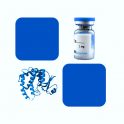
- Remove this product from my favorite's list.
- Add this product to my list of favorites.
Products
Newsletter
 |  |  |  |  |  |

Background
Programmed cell death 1 ligand 1 (PDL1) is also known as B7-H, B7H1, MGC142294, MGC142296, PD-L1, PDCD1L1 and PDCD1LG1,which is a member of the growing B7 family of immune molecules and is involved in the regulation of cellular and humoral immune responses.PDL1 is a cell surface immunoglobulin superfamily with two Ig-like domains within the extracellular region and a short cytoplasmic domain. This protein is broadly expressed in the majority of peripheral tissues as well as hematopoietic cells. Interaction between PDL1 and its receptors belonging to the CD28 family of molecules provide both stimulatory and inhibitory signals in regulating T cell activation and tolerance. PDL1 may inhibit ongoing T-cell responses by inducing apoptosis and arresting cell-cycle progression.
Source
Recombinant Biotinylated Human PD-L1, Avitag,His Tag (PD1-H82E5) is expressed from human 293 cells (HEK293). It contains AA Phe 19 - Arg 238 (Accession # NP_054862.1).
Predicted N-terminus: Phe 19
Molecular Characterization
This protein carries an Avi tag (Avitag™) at the C-terminus, followed by a polyhistidine tag
The protein has a calculated MW of 27.8 kDa. The protein migrates as 33-40 kDa when calibrated against Star Ribbon Pre-stained Protein Marker under reducing (R) condition (SDS-PAGE) due to glycosylation.
Biotinylation
Biotinylation of this product is performed using Avitag™ technology. Briefly, the single lysine residue in the Avitag is enzymatically labeled with biotin.
Biotin:Protein Ratio
Passed as determined by the HABA assay / binding ELISA.
Endotoxin
Less than 1.0 EU per μg by the LAL method.
Purity
>95% as determined by SDS-PAGE.
>90% as determined by SEC-MALS.
Formulation
Lyophilized from 0.22 μm filtered solution in PBS, pH7.4 with trehalose as protectant.
Reconstitution
For best performance, we strongly recommend you to follow the reconstitution protocol provided in the COA.
Storage
For long term storage, the product should be stored at lyophilized state at -20°C or lower.
Please avoid repeated freeze-thaw cycles.
This product is stable after storage at:
-20°C to -70°C for 12 months in lyophilized state;
-70°C for 3 months under sterile conditions after reconstitution.
Bioactivity
Please refer to product data sheet.
(1) "Hsc70 promotes anti-tumor immunity by targeting PD-L1 for lysosomal degradation"
Xu, Xie, Zhou et al
Nat Commun (2024) 15 (1), 4237
(2) "Regulatory mechanisms of PD-1/PD-L1 in cancers"
Lin, Kang, Chen et al
Mol Cancer (2024) 23 (1), 108
(3) "Trifluridine/tipiracil + oxaliplatin ± nivolumab vs FOLFOX ± nivolumab in HER2 negative advanced oesogastric adenocarcinoma: The PRODIGE73-UCGI40-LOGICAN trial"
Botsen, Chabaud, Perrier et al
Dig Liver Dis (2024)
Showing 1-3 of 29784 papers.
(1) "A small-sized protein binder specific for human PD-1 effectively suppresses the tumor growth in tumor mouse model"
Authors: Son S, et al
Journal: J Drug Target 2019
Application: ELISA
(2) "Comprehensive in vitro characterization of PD-L1 small molecule inhibitors"
Authors: Ganesan A, et al
Journal: Sci Rep 2019
Application: ELISA
(3) "Anti-pd-1 antibodies and methods of use thereof"
Authors: Yasmina Noubia Abdiche, et al.
Journal: US20160159905A1 2016
Application: Flow Cytometry
Recombinant Human PD-L1/B7-H1 Protein, low endotoxin, Fc Tag, 100µg - 429,00 €
Recombinant Human PD-1 / PDCD1 Protein, Fc Tag (HPLC-verified), low endotoxin,100µg - 461,50 €
Recombinant Mouse PD-L1 /CD274 /B7-H1 Protein, With C-Fc Tag, 200µg - 364,00 €
Recombinant Mouse PD1 /PDCD1 Protein, Fc Tag, 100µg - 468,00 €
Recombinant Human PD-1 / PDCD1 Protein (HPLC-verified), His Tag, 100µg - 461,50 €
Recombinant Human PD-L1 / B7-H1 Protein (HPLC-verified), His tag, 100µg - 461,50 €
Follow us